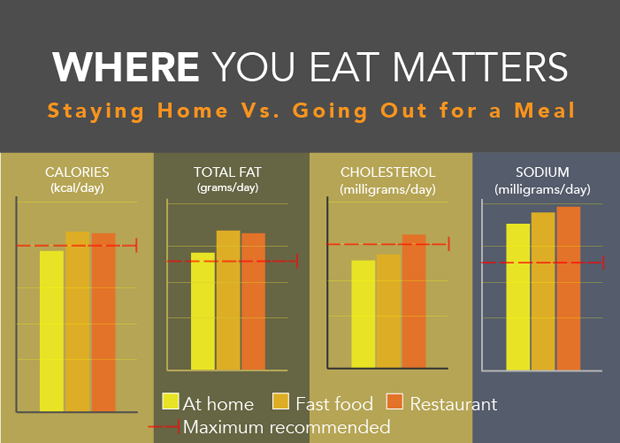Restaurant meals can be as bad for your waistline as fast food
When it comes to your diet, dining out at a restaurant is comparable to -- and in some cases, even less healthy than -- grabbing a bite at a fast food joint, according to a study published today in the European Journal of Clinical Nutrition.
The research found that while people eating at restaurants tend to take in more healthy nutrients, such as certain vitamins, potassium, and omega-3 fatty acids, compared to those who eat at home or at fast food outlets, they also consume substantially more sodium and cholesterol.
The analysis also showed that Americans take in an average of 200 more calories when they dine out, either at a restaurant or fast food outlet, than when eating at home.
"Eating out is often viewed as a social gathering, so people spend more time and eat more leisurely, which can lead to more food intake," the study's author, Rupeng An, assistant professor of in the department of kinesiology and community health at the University of Illinois, told CBS News.
An looked at eight years of data from more than 18,000 adults who participated in the National Health and Nutrition Examination Survey, which is conducted by the National Center for Health Statistics.
His analysis showed that people who ate at full-service restaurants consumed about 58 additional milligrams of cholesterol per day than those who ate at home. This is concerning, An said, as it "accounts for 20 percent of the recommended upper bound of total cholesterol intake of 300 milligrams per day."
Fast-food diners also took in extra cholesterol, but only 10 more milligrams on average than those who stayed home for meals.
Dining at either a fast food joint or a full-service restaurant led to more saturated fat intake and 10 grams more total fat intake than eating at home.
When it came to sodium, eating at a restaurant led to an average increase of 412 milligrams per day, while fast food added about 300 milligrams per day. The dietary guidelines from the U.S. Departments of Agriculture and Health and Human Services recommend between 1,500 and 2,300 milligrams of sodium per day, but reports show the average American consumes well over 3,000 milligrams per day.
"The additional sodium is even more worrisome because the average daily sodium intake among Americans is already so far above the recommended upper limit, posing a significant public health concern, such as hypertension and heart disease," An said in a statement.
The results of the study did not surprise Lori Rosenthal, a registered dietitian who specializes in weight management at Montefiore Medical Center in New York City. "When we prepare our own meals we know exactly what we are eating," she said. "We are in control. When dining out, we are leaving the ingredients to the chef."
She recommends eating and preparing meals at home as much as possible and planning ahead to help ensure healthier decision making. "Take a look at the upcoming week and see what you have planned in terms of work, appointments, and social commitments," she said. "Next, choose meals for each day. Write down each item needed to make your plan happen and go grocery shopping. Don't forget to read the nutrition labels, not just packaging claims when making your choices. After grocery shopping, take some time to meal prep or even cook dishes in advance."
Finally, if dining out is the only option, Rosenthal suggests looking up menus online before going to the restaurant to choose the healthiest option; sticking to baked, broiled, grilled, or steamed dishes; and asking for sauces and dressings on the side to control fat and calorie intake.
And when you sit down for a meal, "be mindful," she said. "Take the time to chew, taste, and savor your food. You'll naturally eat less and enjoy your meals even more."

